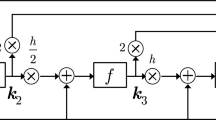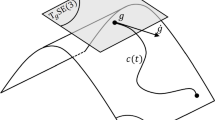Abstract
In this paper, the problem of diagonalizing a symmetric matrix stream (or say, time-varying matrix) is investigated. To fulfill our goal of diagonalization, two error functions are constructed. By making the error functions converge to zero with zeroing neural dynamics (ZND) design formulas, a continuous ZND model is established and its effectiveness is then substantiated by simulative results. Furthermore, a Zhang et al. discretization (ZeaD) formula with high precision is developed to discretize the continuous ZND model. Thus, a new 5-point discrete ZND (DZND) model is further proposed for diagonalization of matrix stream. Theoretical analyses prove the stability and convergence of the 5-point DZND model. In addition, simulative experiments are carried out, of which the results substantiate not only the efficacy of the proposed 5-point DZND model but also its higher computational precision as compared with the conventional Euler-type and 4-point DZND models for diagonalization of symmetric matrix stream.







Similar content being viewed by others
References
Parlett, G.N.: The Symmetric Eigenvalue Problem. Prentice Hall, New Jersey (1998)
Mayer, C.D.: Matrix Analysis and Applied Linear Algebra. Society for Industrial and Applied Mathematics, Philadelphia (2000)
Golub, G.H., Van Loan, C.F.: Matrix Computations. The Johns Hopkins University Press, Baltimore (2013)
Jarlebring, E., Koskela, A., Mele, G.: Disguised and new quasi-Newton methods for nonlinear eigenvalue problems. Numer. Algorithms 79, 311–335 (2018)
Zhao, K., Cheng, L., Li, S.: A new updating method for the damped mass-spring systems. Appl. Math. Model. 62, 119–133 (2018)
Yang, P., Shang, P.: Recurrence quantity analysis based on matrix eigenvalues. Commun. Nonlinear. Sci. 59, 15–29 (2018)
Lee, Z., Hambach, R., Kaiser, U., Rose, H.: Significance of matrix diagonalization in modelling inelastic electron scattering. Ultramicroscopy 175, 58–66 (2017)
Al-Bahrani, L.T., Patra, J.C.: A novel orthogonal PSO algorithm based on orthogonal diagonalization. Swarm Evol. Comput. 40, 1–23 (2018)
Chen, K., Yi, C.: Robustness analysis of a hybrid of recursive neural dynamics for online matrix inversion. Appl. Math. Comput. 273, 969–975 (2016)
Xiao, L.: A finite-time convergent Zhang neural network and its application to real-time matrix square root finding. Neural. Comput. Appl. 10, 1–8 (2017)
Guo, D., Nie, Z., Yan, L.: Novel discrete-time Zhang neural network for time-varying matrix inversion. IEEE Trans. Syst., Man, Cybern. Syst. 47, 2301–2310 (2017)
Xiao, L., Liao, B., Li, S., Chen, K.: Nonlinear recurrent neural networks for finite-time solution of general time-varying linear matrix equations. Neural Netw. 98, 103–113 (2018)
Zhang, Y., Qi, Z., Li, J., Qiu, B., Yang, M.: Stepsize domain confirmation and optimum of ZeaD formula for future optimization. Numer. Algorithms 81, 561–573 (2019)
Xiao, L., Li, S., Yang, J., Zhang, Z.: A new recurrent neural network with noise-tolerance and finite-time convergence for dynamic quadratic minimization. Neurocomputing 285, 125–132 (2018)
Jin, L., Li, S., Hu, B.: RNN models for dynamic matrix inversion: a control-theoretical perspective. IEEE Trans. Ind. Inform. 14, 189–199 (2018)
Petkovic, M.D., Stanimirovic, P.S., Katsilis, V.N.: Modified discrete iterations for computing the inverse and pseudoinverse of the time-varying matrix. Neurocomputing 289, 155–165 (2018)
Baumann, M., Helmke, U.: Diagonalization of time-varying symmetric matrices. In: Proceedings of International Conference on Computational Science (ICCS), Amsterdam, Netherlands, pp. 419–428 (2002)
Zhang, Y., Yi, C.: Zhang Neural Networks and Neural-Dynamic Method. Nova Science Publishers, New York (2011)
Zhang, Y., Xiao, L., Xiao, Z., Mao, M.: Zeroing Dynamics, Gradient Dynamics, and Newton Iterations. CRC Press, Boca Raton (2015)
Qiu, B., Zhang, Y., Yang, Z.: Analysis, verification and comparison on feedback-aided Ma equivalence and Zhang equivalency of minimum-kinetic-energy type for kinematic control of redundant robot manipulators. Asian J. Control 20, 2154–2170 (2018)
Li, J., Mao, M., Uhlig, F., Zhang, Y.: Z-type neural-dynamics for time-varying nonlinear optimization under a linear equality constraint with robot application. J. Comput. Appl. Math. 327, 155–166 (2018)
Xiao, L., Liao, B., Li, S., Zhang, Z., Ding, L., Jin, L.: Design and analysis of FTZNN applied to the real-time solution of a nonstationary Lyapunov equation and tracking control of a wheeled mobile manipulator. IEEE Trans. Ind. Inform. 14, 98–105 (2018)
Qiao, S., Wang, X., Wei, Y.: Two finite-time convergent Zhang neural network models for time-varying complex matrix Drazin inverse. Linear Algebra Appl. 542, 101–117 (2018)
Jin, L., Zhang, Y.: Continuous and discrete Zhang dynamics for real-time varying nonlinear optimization. Numer. Algorithms 73, 115–140 (2016)
Guo, D., Lin, X., Su, Z., Sun, S., Huang, Z.: Design and analysis of two discrete-time ZD algorithms for time-varying nonlinear minimization. Numer. Algorithms 77, 23–36 (2018)
Zhang, Y., Chou, Y., Zhang, Z., Xiao, L.: Presentation, error analysis and numerical experiments on a group of 1-step-ahead numerical differentiation formulas. J. Comput. Appl. Math. 239, 406–414 (2013)
Jin, L., Zhang, Y.: Discrete-time Zhang neural network for online time-varying nonlilnear optimazation with application to manupulator motion generation. IEEE Trans. Neural Netw. Learn. Syst. 26, 1525–1531 (2015)
Mathews, J.H., Fink, K.D.: Numerical Methods Using MATLAB. Prentice Hall, New Jersey (2004)
Jin, L., Zhang, Y.: Discrete-time Zhang neural network of O(τ3) pattern for time-varying matrix pseudoinversion with application to manipulator motion generation. Neurocomputing 142, 165–173 (2014)
Zhang, Y., Yang, M., Li, J., He, L., Wu, S.: ZFD formula 4Ig SFD_Y applied to future minimization. Phys. Lett. A 381, 1677–1681 (2017)
Shi, Y., Qiu, B., Chen, D., Li, J., Zhang, Y.: Proposing and validation of a new four-point finite-difference formula with manipulator application. IEEE Trans. Ind. Inform. 14, 1323–1333 (2018)
Griffiths, D.F., Higham, D.J.: Numerical Methods for Ordinary Differential Equations: Initial Value Problems. Springer, London (2010)
Suli, E., Mayers, D.F.: An Introduction to Numerical Analysis. Cambridge University Press, Cambridge (2003)
Funding
This work is supported by the National Natural Science Foundation of China (with number 61976230), by the China Postdoctoral Science Foundation (with number 2018M643306), by the Guangdong Basic and Applied Basic Research Foundation (with number 2019A1515012128), by the Fundamental Research Funds for the Central Universities (with number 19lgpy227), and also by the Shenzhen Science and Technology Plan Project (with number JCYJ20170818154936083).
Author information
Authors and Affiliations
Corresponding author
Additional information
Publisher’s note
Springer Nature remains neutral with regard to jurisdictional claims in published maps and institutional affiliations.
Appendices
Appendix 1
Suppose that
and
Let dij and yij denote the ij th elements of D and Y, respectively. We have
Then, the ij th element of matrix E equals yij(dii − djj) with i≠j and i,j = 1, 2,…,n. Since the diagonal elements of D are distinct, yij (with i≠j and i,j = 1, 2,…,n) must equal zero so that yij(dii − djj) equals zero. Thus, matrix Y is diagonal. The proof is completed.
Appendix 2
Given an N-step method \(\sum \nolimits _{i= 0}^{N} {\alpha _{i} x_{k +i}}=\tau \sum \nolimits _{i = 0}^{N} \beta _{i} \psi _{k +i}\) with its first and second characteristic polynomials being \(P_{N}(\varsigma ) = \sum \nolimits _{i = 0}^{N} \alpha _{i} \varsigma ^{i}\) and \(p_{N}(\varsigma ) = \sum \nolimits _{i = 0}^{N} \beta _{i} \varsigma ^{i}\), we have the following definition and results [32, 33] as the basis of DZND research.
- Definition of root condition: :
-
A polynomial ρ(ς) satisfies the root condition if all its roots satisfy |ς|≤ 1 and any roots that satisfy |ς| = 1 are simple.
- Result 1: :
-
An N-step method is said to be zero-stable if the first characteristic polynomial satisfies the root condition.
- Result 2: :
-
An N-step method is consistent if its first and second characteristic polynomials satisfy PN(1) = 0 and \(P^{\prime }_{N}(1)=p_{N}(1)\neq 0\). The N-step method is consistent of order q if the truncation error for the exact solution is of order O(τq).
- Result 3: :
-
An N-step method is convergent if and only if the method is zero-stable and consistent. That is, zero-stability plus consistency means convergence, which is also known as Dahlquist equivalence theorem.
- Result 4: :
-
A zero-stable consistent N-step method converges with the order of its truncation error.
Rights and permissions
About this article
Cite this article
Zhang, Y., Huang, H., Yang, M. et al. New zeroing neural dynamics models for diagonalization of symmetric matrix stream. Numer Algor 85, 849–866 (2020). https://doi.org/10.1007/s11075-019-00840-5
Received:
Accepted:
Published:
Issue Date:
DOI: https://doi.org/10.1007/s11075-019-00840-5




